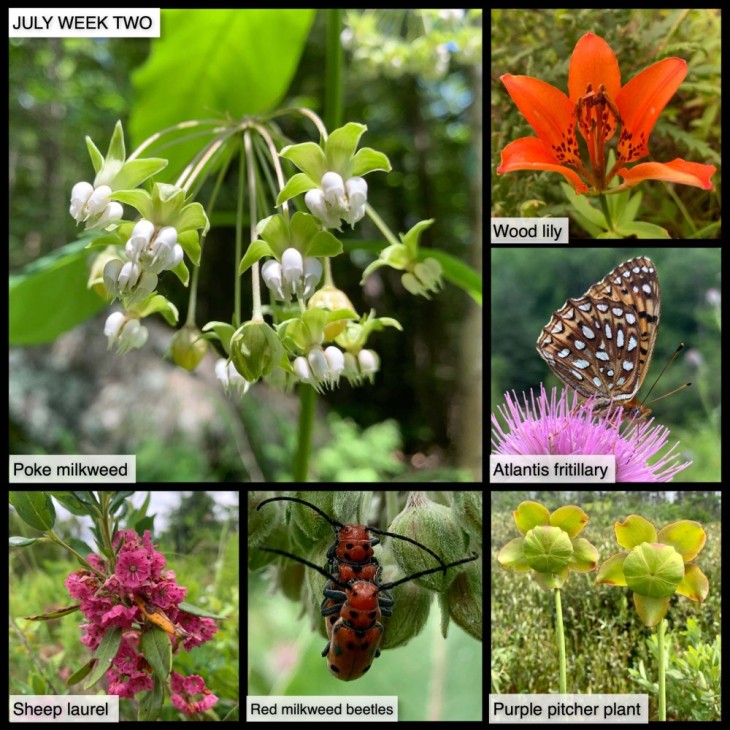This Week in the Woods, we asked Jason Berard, vice president of stewardship at Upper Valley Land Trust, to take photos for this blog. He graciously agreed to help us, and shared more cool plant images than we could fit into one post. All of these photos were taken on land that is owned or has been conserved by Upper Valley Land Trust. To learn about its publicly accessible trails and properties, check out this link. And thank you, Jason!
So, what did he find?
On Lyme Hill, poke milkweed is blooming. This taller, somewhat more shade-tolerant cousin of pink common milkweed grows on forest edges as well as in sunny, disturbed sites. It’s a host plant for monarch butterfly caterpillars, and its nectar attracts a variety of pollinators. Here’s a profile from The Native Plant Trust.
The trouble with wood lilies is that deer like to eat them, and it can be a bit depressing to scope out soon-to-bloom plants, then come back to find a nibbled stem. They’re worth the hunt, however, with brilliant orangey-red tepals (fused petals and sepals) that have speckles and sometimes, splashes of yellow. Wood lilies are also distinctive for their orientation; it’s unusual to find another type of lily facing directly upward, as these often do. Here’s a profile from the Lady Bird Johnson Wildflower Center, which notes that the plants attract hummingbirds. Wood lilies bloom from now into August.
The best way to distinguish between the look-alike Aphrodite and Atlantis fritillary is to look deeply into the butterfly’s eyes. Are the eyes blue, or at least blueish? Then it’s probably an Atlantis. Fritillaries (several species in our region) rely mostly on violets as host plants for their caterpillars. According to this profile from the U.S. Forest Service, their name derives from the Latin fritillus, which means dice box or chessboard, and is a reference to the checkering on their wings.
Pitcher plants are blooming now. Like sundews, they’re carnivorous plants, but they take a more passive approach to acquiring meals. They simply form wells with their leaves, which serve as watery traps in which insects and other small prey drown, decompose, and are partially absorbed. Check out this somewhat disturbing Outside Story essay by Brett Amy Thelen, describing researchers’ discovery at a bog in Ontario that many of the pitcher plants were feeding on salamanders. And here’s an interesting article from the Summer 2012 issue of the magazine, describing how “tiny microstructures” on the leaves’ surface trap fluid and cause prey to hydroplane.
The brilliant coloring of red milkweed beetles is a warning to birds and other would-be predators that the beetles are steeped in cardiac glycosides. As noted in this post from the University of Wisconsin Milwaukee Field Station, the beetles feed on milkweed at all stages of their lives, from early days as root chomping larvae to adulthood, when they feed on the top parts of the plant, including its flowers. Milkweed beetles, like monarch caterpillars, can die if the plant’s defensive goo – sticky white latex – fills up and seals their mouths. To avoid this fate, they drain leaf veins around their feeding site. (In monarchs, this behavior is sometimes called trenching.) Another fun fact noted in the UWM Field Station blog: if you pick up a milkweed beetle and listen very closely, you may hear it purr or squeak. See this Outside Story essay by Barbara Mackay, describing other creatures that may inhabit a milkweed patch.
Keep an eye out for bright pink blooming sheep laurel, which often appears in difficult growing conditions such as at the edges of bogs. It gets its name from the fact that it is toxic to sheep, as well as to many other mammals (including humans, but apparently not caribou). Here’s a profile from the U.S. Forest Service, which describes its tendency to reproduce clonally, and how it often sprouts after a fire.
And finally, if you’d like to know more about the photographer who took these great images and his work at Upper Valley Land Trust, check out this Community Voices interview with Meghan McCarthy McPhaul from the Northern Woodlands archive.
Our thanks to The Bailey Charitable Foundation and the Frank and Brinna Sands Foundation for helping to support this series.
In this difficult period, many of us find joy in observing local nature. This series, launched in April 2020, shares nature photographs taken in the past seven days, or in the same week in 2020, most within 15 miles of the Northern Woodlands office in Lyme, New Hampshire. We hope you enjoy using this grid as a prompt for your own explorations.
What are you seeing in the woods this week? Share your images with us on Facebook, or submit a special photo for possible inclusion in our monthly online Reader Photo Gallery.


